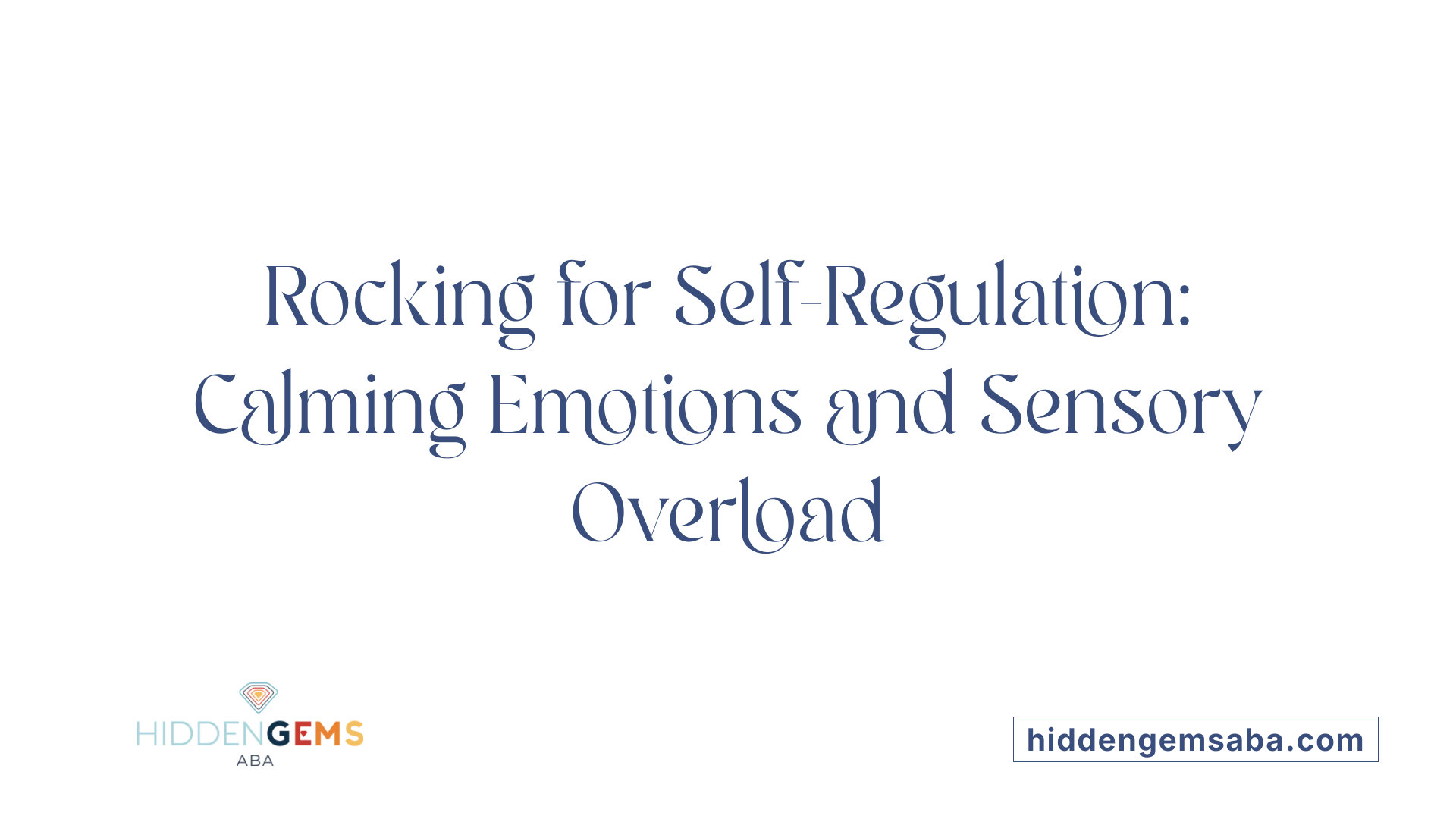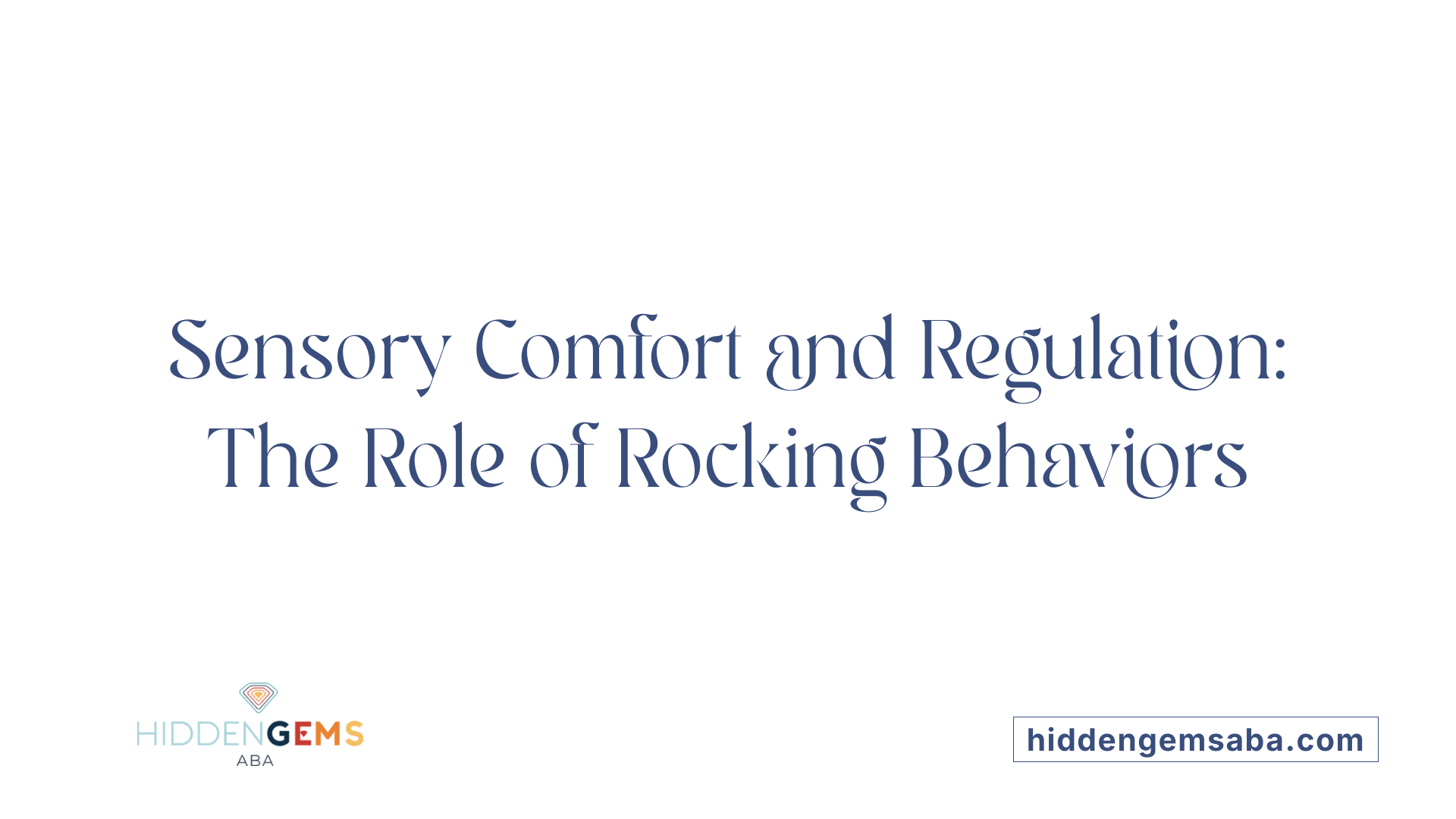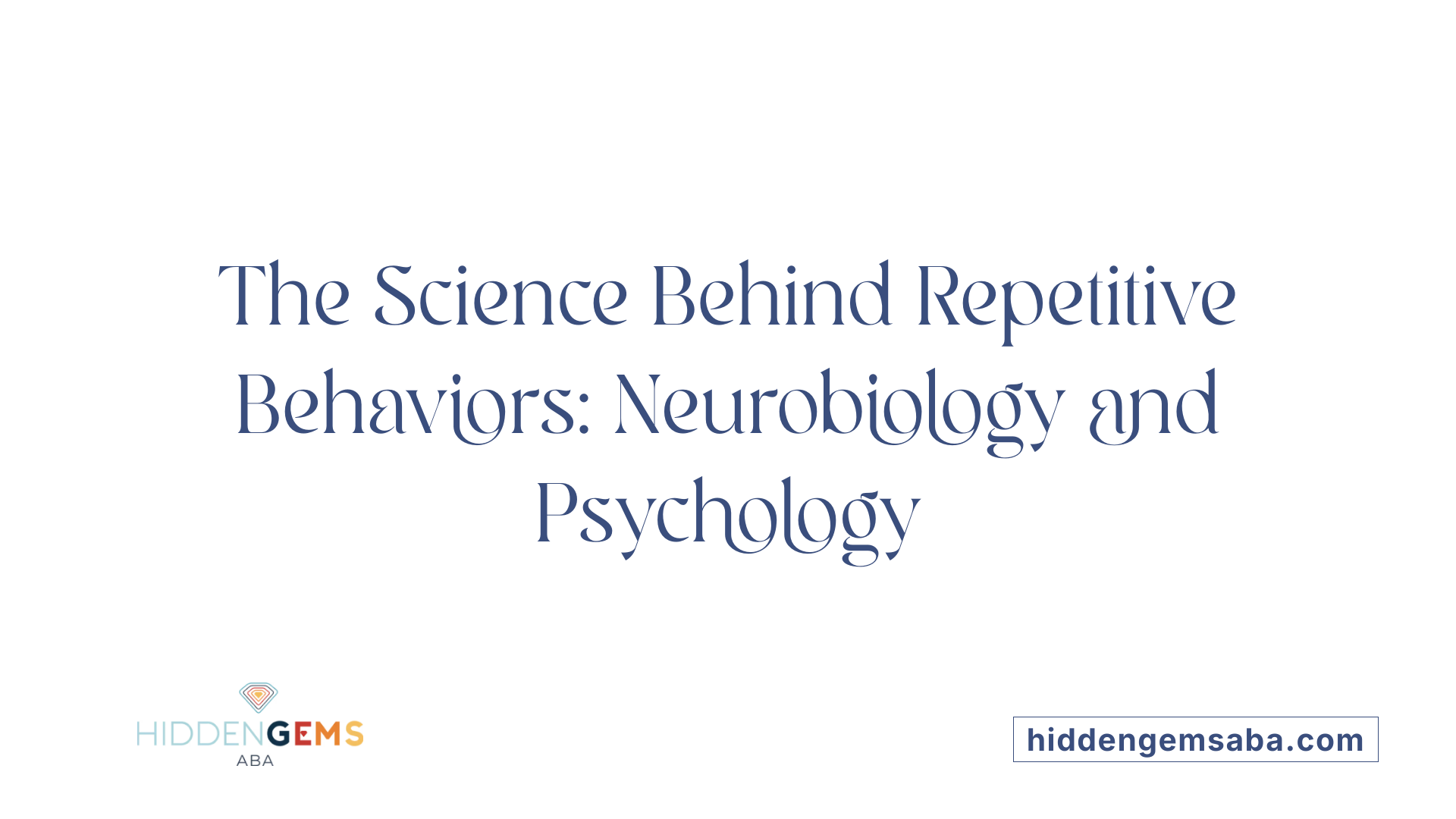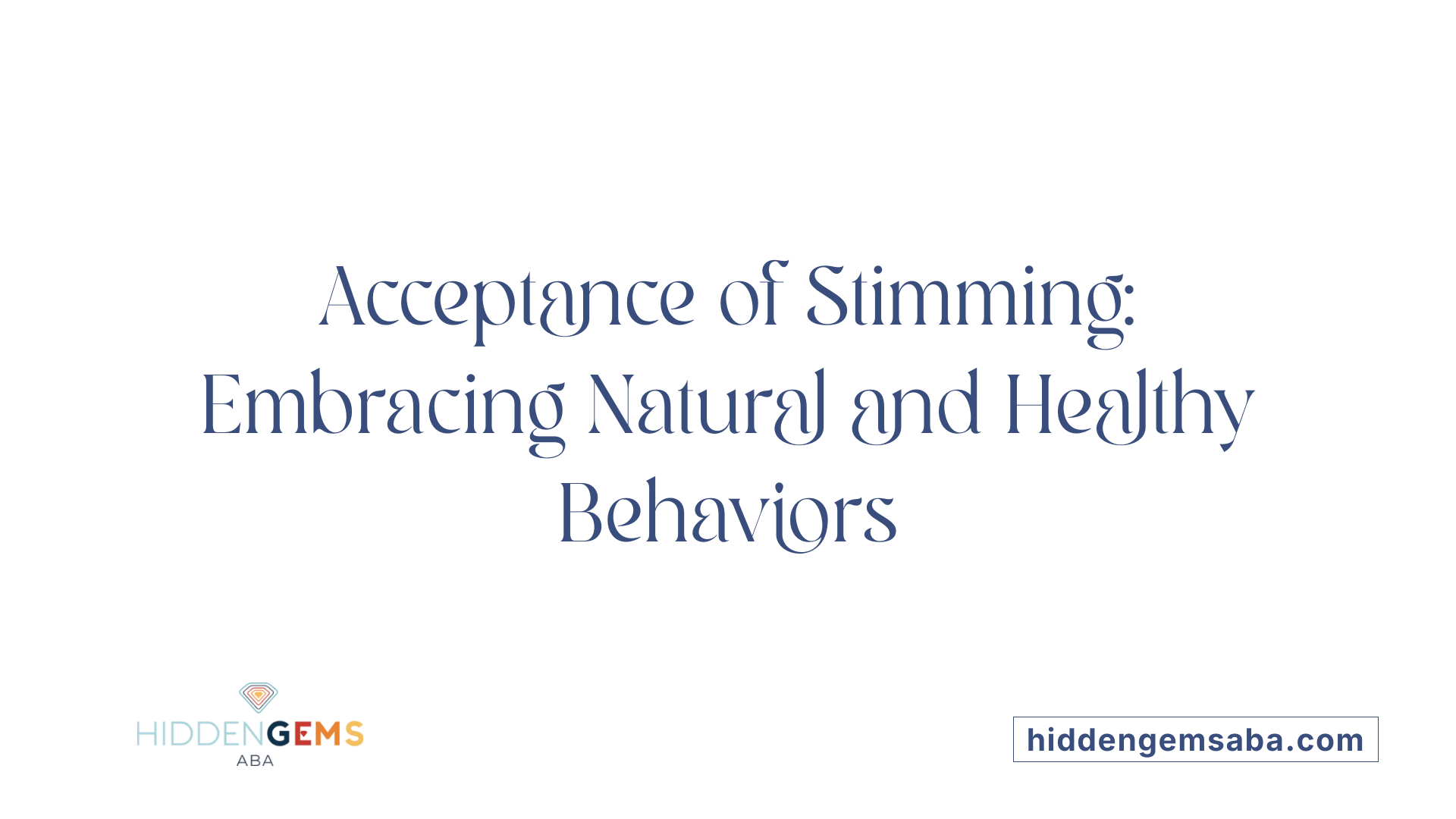Deciphering the Purpose Behind Repetitive Behaviors in Autism
Rocking is one of the most recognizable self-stimulatory behaviors observed in many autistic individuals. While often visible and seemingly simple, this repetitive motion holds deeper psychological, sensory, and emotional significance. This article explores why autistic people engage in rocking, the science behind it, and how it functions as an essential self-regulation tool.
Defining Stimming and Its Role in Autism

What is stimming and how is it involved in autism?
Stimming, short for self-stimulation, involves repetitive movements, sounds, or the use of objects. It is a common behavior found in many people, but it is particularly prominent among individuals with autism. This behavior serves multiple purposes, including managing sensory input, expressing emotions, and reducing stress.
In the context of autism, stimming is recognized as a core component of the condition. It is included in the DSM-5 as part of the diagnostic criteria for Autism Spectrum Disorder. For autistic individuals, stimming can be more frequent and intense than in neurotypical people, often helping them cope with overwhelming sensory environments or emotional experiences.
Common forms of stimming include hand flapping, rocking, spinning, repeating words or sounds, and engaging with objects like spinning toys. These behaviors can soothe, calm, or alert the individual, depending on their needs at the moment.
While some stimming behaviors are harmless and serve essential functions, they might sometimes interfere with daily activities or social interactions. However, understanding that these behaviors often provide comfort or regulate sensory input is vital. Support strategies aim to respect these natural behaviors while managing any potential negative impacts.
In summary, stimming is a natural, often helpful behavior that plays a significant role in how autistic people experience and navigate their sensory and emotional worlds.
The Functionality of Rocking in Emotional and Sensory Regulation

Why do autistic individuals rock?
Autistic individuals often rock as a way to regulate their sensory experiences and emotions. This repetitive movement helps them manage overwhelming sensory input, such as bright lights or loud noises, by providing predictable and calming sensory stimulation. Rocking can serve as a self-soothing activity that helps reduce feelings of anxiety and stress.
The act of rocking aligns with their need for sensory input, filling sensory gaps that might cause discomfort or confusion. It is also a way to express their emotions nonverbally, whether they are feeling happy, distressed, or overwhelmed.
The calming effects of rocking
Many autistic people find rocking to be inherently calming and comforting. The rhythmic motion can trigger a soothing response in the brain, releasing feel-good chemicals that promote relaxation.
Rocking also stimulates the vestibular system, which is responsible for balance and spatial awareness. This stimulation helps some individuals feel more in control of their environment, especially during moments of sensory overload or emotional distress.
Additionally, the repetitive nature of rocking creates a soothing, rhythmic sensation that can help block out unpleasant external stimuli like bright lights or loud sounds, providing a barrier that makes the environment more manageable.
Rocking as a form of self-soothing
For many, rocking isn't just about sensory regulation; it is also a primary self-soothing behavior. It offers a sense of predictability and security, especially during unsettling situations. This self-soothing effect helps reduce anxiety and stress, enabling autistic individuals to regain their composure and focus.
Moreover, in some cases, rocking serves as a form of nonverbal communication, conveying needs or feelings when words are difficult to express. It can also be a joyful activity, showcasing happiness or excitement.
Supporting this behavior is important because it is a natural, beneficial way for autistic individuals to manage their emotional and sensory worlds. Encouraging safe and harmless forms of stimming like rocking can significantly improve their wellbeing and quality of life.
Why do autistic people engage in stimming behaviors, like rocking?
Autistic people engage in rocking to regulate sensory input, manage strong emotions, and reduce anxiety. It acts as a self-soothing mechanism to cope with sensory overload, unfamiliar environments, or stress.
Rocking's Role in Sensory Modulation and Comfort

What is the purpose and significance of rocking behaviors in autism?
Rocking behaviors are a common form of self-stimulation among autistic individuals. They serve important functions related to how people manage their sensory experiences and emotions. For many, rocking helps to soothe and calm — acting as a way to reduce feelings of stress or anxiety. It can also be a source of pleasure, providing sensory input that feels enjoyable and comforting.
In autism, sensory overload is a frequent challenge. Bright lights, loud noises, or overwhelming environments can cause distress. Rocking creates a predictable, rhythmic sensation that helps block out or lessen the impact of excess sensory input. This calming movement can make a person feel more in control of their environment and help them regain focus or composure.
Conversely, some autistic individuals seek out sensory input through rocking to fill sensory gaps. This behavior can provide the stimulation their nervous system craves, helping to balance their sensory needs. The repetitive nature of rocking also helps to organize sensory input and regulate emotional states.
Sensory overload and sensory seeking behaviors
Sensory overload occurs when too much sensory information overwhelms the nervous system. Autistic people might respond by engaging in self-initiated behaviors like rocking, spinning, or hand flapping to interrupt or filter the overload.
On the other hand, sensory seeking behaviors are driven by the need for additional input. When someone seeks more stimulation, rocking can serve as an easy way to achieve that. It often creates a calming, rhythmic feeling, similar to the way listening to music or dancing can be pleasurable for neurotypical people.
How rocking helps block out or seek sensory stimuli
Rocking acts as a natural sensory regulator. It helps block out distressing stimuli like loud noises or harsh lights, providing a predictable sensory experience that calms the nervous system.
At the same time, rocking can serve as a way to actively seek sensory input. It fills a sensory gap, creating a sense of pleasure and control. This dual role underscores the importance of understanding rocking not as a problem but as a useful behavior for self-management.
The connection between rocking and sensory integration
Expertise in sensory integration highlights that behaviors like rocking can help improve the way the brain processes sensory information. By engaging in rhythmic, repetitive movements, individuals may stimulate their vestibular system — responsible for balance and spatial awareness — leading to better overall sensory processing.
Repetitive movements like rocking can also trigger the release of feel-good chemicals in the brain, promoting relaxation. Many autistic people report that rocking helps them feel more stable and less overwhelmed. Recognizing this, caregivers and educators are encouraged to support rather than suppress such behaviors, unless safety or social considerations require intervention.
| Behavior Type | Purpose | Effect | Typical Triggers |
|---|---|---|---|
| Sensory Overload Response | Reduce overwhelming input | Creates a calming, rhythmic sensation | Bright lights, loud noises |
| Sensory Seeking | Fill sensory gaps | Produces pleasurable, soothing feelings | Boredom, low arousal |
| Emotional Regulation | Manage anxiety/stress | Self-soothing and comfort | Change of environment, emotional upset |
Understanding why rocking occurs helps foster empathy and emphasizes that such behaviors are natural ways for autistic individuals to handle sensory and emotional challenges.
Scientific and Psychological Underpinnings of Repetitive Behaviors

What are the scientific or psychological reasons behind repetitive behaviors like rocking?
Repetitive behaviors such as rocking are rooted in both neurobiological and psychological processes. These actions serve to provide calming or stimulating sensory input, which helps individuals regulate their sensory experiences—especially when faced with sensory overload or under-stimulation.
From a neurobiological perspective, these behaviors often stimulate the vestibular system, responsible for balance and spatial awareness. Engaging in movements like rocking can trigger the release of endorphins, the brain’s natural painkillers and mood lifters, contributing to feelings of calmness and pleasure.
Psychologically, rocking and similar behaviors act as self-soothing mechanisms. They help reduce anxiety, emotional tension, or feelings of distress by creating a predictable, rhythmic sensory experience. This can be especially important for autistic individuals, who may experience heightened sensory sensitivities.
In summary, self-stimulatory movements like rocking are vital for maintaining emotional stability and sensory equilibrium. They help manage overwhelming environments, calm physiological stress responses, and often serve as a non-verbal form of expressing internal emotional states.
How does sensory processing difference impact behaviors like stimming?
Differences in sensory processing are central to understanding stimming behaviors. Individuals with sensory sensitivities may find certain stimuli either too intense or insufficient, leading them to engage in repetitive behaviors to self-regulate.
For example, an autistic person might rock to block out loud noises or bright lights, effectively filtering sensory input to create a more manageable environment.
Conversely, they might seek out additional sensory input—such as spinning or hand-flapping—to fill sensory gaps that cause discomfort or boredom.
These behaviors serve as a bridge between internal sensory states and external stimuli, helping individuals feel more in control. Recognizing these behaviors as adaptations rather than problems fosters empathy and encourages supportive strategies.
| Behavioral Function | Description | Sensory Aspect | Impact on Well-Being |
|---|---|---|---|
| Self-Regulation | Using movement to calm or energize | Over or under-stimulation | Reduces stress and enhances focus |
| Sensory Seeking | Actively pursuing sensory input | Tactile, visual, auditory | Provides pleasure and joy |
| Emotional Expression | Conveying feelings non-verbally | Frustration, excitement | Communicates internal states |
Understanding these underlying reasons shifts the focus from suppression to support, emphasizing the importance of respecting natural behaviors.
Rocking as a Nonverbal Language and a Communication Tool
What is the purpose and significance of rocking behaviors in autism?
For many autistic individuals, rocking is more than just a repetitive movement; it often serves as a form of nonverbal communication. When verbal skills are limited or not present, rocking can become a crucial way to convey feelings or needs.
Rocking can express a wide range of emotions, such as happiness, excitement, or distress. It provides a predictable and soothing way to signal these states to caregivers or others around them.
This behavior acts as a self-stimulatory activity that helps individuals self-regulate, but it also carries an additional layer of meaning—almost like a language without words. By observing the context and manner of rocking, those close to the person can better understand their emotional state or specific needs.
Supporting individuals with limited verbal skills
Supporting autistic individuals who use rocking as a communication tool involves understanding its importance and respecting their need to stim. Instead of discouraging the behavior, caregivers are encouraged to interpret it as a vital form of expression.
Professionals may help develop alternative communication methods, such as visual aids or sign language, to complement rocking and give the individual other ways to express themselves. This approach can reduce frustration and improve overall communication if verbal skills are developing.
Rocking as an expression of joy or distress
In addition to being a form of communication, rocking often reflects internal emotional states. When happy or excited, an individual might rock with enthusiasm, showing their delight.
Conversely, rocking can also indicate stress, anxiety, or discomfort. It can be a way to cope with overwhelming sensory input or emotional distress, helping the person feel more in control.
Understanding these nuances emphasizes that rocking is not inherently problematic. It is a natural part of how some autistic people engage with their environment and express themselves.
For more insights, searching "Rocking as communication in autism" can provide additional strategies and understanding of this behavior.
The Natural and Acceptable Aspect of Stimming Behaviors

Does rocking behavior in children or adults suggest autism?
Rocking is a common self-stimulatory activity observed in many individuals, including those with autism. It can serve various purposes, such as self-regulation and sensory input, and is often part of broader repetitive behaviors. However, rocking alone is not a definitive sign of autism; it can also be seen in neurotypical individuals, especially when they are bored, anxious, or seeking comfort.
While rocking and other stimming behaviors are characteristic components in autism assessments, they do not necessarily indicate a disorder by themselves. Proper diagnosis involves a comprehensive evaluation by health professionals who consider a range of behaviors, developmental history, and other factors.
Understanding this helps shift the focus towards acceptance and support rather than judgment or stigma. Recognizing that stimming behaviors like rocking are natural ways for individuals to cope with sensory input and emotions fosters empathy and promotes a more inclusive attitude.
Autism acceptance and neurodiversity
Accepting stimming behaviors forms part of the wider movement of neurodiversity, which emphasizes respecting neurological differences as natural variations of human experience. Many autistic individuals see stimming as an essential part of self-regulation and emotional expression.
Supporting neurodiversity means valuing accessible environments and reducing unnecessary pressures to conform to neurotypical behaviors. When stimming is understood and supported, autistic individuals can feel more comfortable and respected, encouraging better mental wellbeing.
Why suppressing stimming can be problematic
Trying to suppress natural stimming behaviors can lead to increased stress, anxiety, and feelings of invalidation. For many, these behaviors serve crucial functions, such as reducing sensory overload or managing emotional distress.
Attempts to eliminate or restrain stimming often ignore the underlying needs it addresses. This can cause harm by making individuals feel misunderstood or alienated. It may also increase the risk of developing maladaptive behaviors or emotional issues.
Supporting natural behaviors
Supporting stimming involves understanding its purpose and allowing space for these behaviors within social and environmental contexts.
Some strategies include:
- Creating sensory-friendly environments
- Providing safe and acceptable outlets for stimming
- Educating caregivers and educators about its value
- Implementing interventions that teach self-regulation skills without eliminating stimming
Promoting acceptance not only improves quality of life but also fosters a sense of autonomy and self-identity. Recognizing that behaviors like rocking are natural responses to sensory needs helps build a more compassionate, inclusive society.
| Behavior | Function | Supporting Strategies |
|---|---|---|
| Rocking | Self-regulation, calming, seeking sensory input | Allow within safe settings, provide alternative sensory activities |
| Hand flapping | Expressing excitement, covering sensory overload | Observe context, offer sensory breaks |
| Spinning | Stimulating vestibular system, comfort | Use sensory toys, create designated calming areas |
Understanding and respecting stimming as a natural behavior is essential in supporting neurodiverse individuals. Acceptance enables everyone to express their sensory needs without fear of judgment or restriction.
Developmental Aspects and Age-Related Changes in Rocking
Is rocking a common behavior in autistic individuals, and what does it indicate?
Rocking is a widespread behavior among autistic people and is often seen as a self-regulation tool. It involves rhythmic movement, such as swaying back and forth, which helps individuals manage sensory overload, reduce anxiety, or express emotions like happiness or distress.
How does the prevalence of rocking change from childhood to adulthood?
In childhood, rocking is frequently observed as children instinctively use movement to cope with overwhelming sensory input or emotional states. As they grow, some individuals continue to engage in rocking, although the frequency and intensity can vary depending on personal needs and environmental factors.
Do autistic individuals learn to modify or conceal rocking?
Many individuals learn to modify, reduce, or hide their rocking behaviors, especially in social or formal settings where such actions might be misunderstood or deemed inappropriate. This often involves consciously controlling the movement or substituting it with less noticeable behaviors.
Does rocking behavior tend to persist over time?
For some, rocking remains a consistent part of their self-regulatory repertoire throughout life. It can serve as a reliable sensory input method, providing comfort and predictability. Others may reduce their rocking as they develop alternative coping strategies or as their sensory needs change.
Understanding these developmental patterns highlights the importance of supporting individuals in a way that respects their natural behaviors while promoting comfort and functionality.
| Age Group | Typical Behavior Pattern | Possible Reasons | Note |
|---|---|---|---|
| Children (up to 12 years) | Frequent, self-initiated, often vigorous | Sensory regulation, emotional expression | Often more spontaneous and obvious |
| Adolescents | Variable; some reduce or hide rocking | Social pressures, self-awareness | May incorporate subtle movements |
| Adults | Persistent or minimal, depending on individual needs | Self-regulation, comfort, routines | Can serve as a calming strategy |
This trajectory emphasizes that rocking is a natural, adaptive behavior. Recognizing its persistence and variations helps in designing supportive environments that respect personal coping mechanisms, especially as individuals grow older.
Supporting Autistic Self-Regulation and Well-Being

Why do autistic people engage in stimming behaviors, like rocking?
Stimming behaviors, including rocking, serve important functions for autistic individuals. These actions help manage emotional states and sensory experiences, often providing a calming effect. Rocking can block out overwhelming sensory input like bright lights or loud noises, offering a way for individuals to self-regulate and feel more in control.
Autistic individuals also use repetitive movements to seek sensory stimulation that feels pleasurable or comforting. For some, rocking and other stims release natural feel-good chemicals in the brain, such as endorphins, which promote relaxation and reduce stress.
Recognizing these behaviors as natural and beneficial helps foster an environment of understanding and support. Instead of viewing stimming as a problem to be eliminated, it is more helpful to see it as an essential part of self-care and emotional regulation for many autistic people.
Respecting stimming as beneficial
Stimming is a natural behavior that often provides comfort and relief during stressful or overstimulating moments. It can also serve as a form of communication, expressing feelings when words are insufficient. For example, rocking may indicate a need for calming, while hand-flapping might express excitement.
Supporting these behaviors involves respecting an individual's need to stim, especially when it is harmless. Efforts to suppress stimming can increase anxiety and emotional distress, possibly leading to more challenging behaviors.
Balancing safety with natural behaviors
While most stimming is safe, some behaviors can pose risks or interfere with daily activities. It's essential to find a balance between supporting natural behaviors and ensuring safety. For instance, if a particular movement becomes destructive or dangerous, interventions can focus on teaching alternative, safer ways to self-regulate.
Creating a sensory-friendly environment can prevent triggers that lead to excessive or harmful stimming. This might include reducing loud noises, bright lights, or providing calming spaces where autistic individuals can have sensory input at their comfort level.
Strategies to support sensory needs
Supporting sensory regulation involves understanding individual preferences and triggers. Here are some effective strategies:
- Provide sensory tools: Fidget toys, textured fabrics, or noise-canceling headphones can help meet sensory needs.
- Create predictable routines: Consistency can reduce anxiety and minimize the need for disruptive stimming.
- Encourage alternative behaviors: Teaching calming activities like deep breathing or weighted blankets can complement natural stimming.
- Offer safe spaces: Designate quiet areas where individuals can self-regulate without judgment or interruption.
- Educate caregivers and peers: Understanding the purpose of stimming fosters empathy and promotes acceptance.
| Strategy | Purpose | Example |
|---|---|---|
| Sensory tools | Provide comfort and stimulation | Fidget toys, textured decorations |
| Routine | Reduce anxiety | Consistent daily schedule |
| Alternative activities | Calm emotions | Deep breathing exercises |
| Safe spaces | Self-regulation | Quiet corner or sensory room |
| Education | Promote understanding | Autism awareness workshops |
By recognizing the value of stimming behaviors and adopting supportive strategies, we can help autistic individuals navigate their sensory worlds with greater comfort and confidence. Respect and understanding are essential in fostering their well-being and enhancing their quality of life.
Implications for Caregivers, Educators, and Society
Fostering Understanding and Empathy
Recognizing stimming behaviors as natural and beneficial for many autistic individuals is essential in building empathy. These repetitive movements, such as rocking, hand-flapping, or spinning, serve important calming and self-regulation functions. By viewing stimming as a healthy coping mechanism rather than a problem to be fixed, caregivers and educators can support emotional well-being and help reduce stigma. It's helpful to remember that nearly everyone engages in some form of self-stimulatory behavior, especially during moments of boredom or stress.
Creating Supportive Environments
Supportive spaces are vital for allowing autistic individuals to stim safely and comfortably. This involves minimizing sensory overload through quiet areas, dimming bright lights, and reducing loud noises. Encouraging acceptance of stimming and avoiding attempts to suppress these behaviors helps individuals feel seen and understood. Additionally, teaching alternative, socially acceptable ways to self-regulate can promote independence and well-being. For example, offering sensory tools or structured sensory breaks can provide comfort without disrupting social interactions.
Balancing Safety and Acceptance
While most stimming behaviors are harmless, some can pose safety risks if they are aggressive or destructive. It is important to assess each individual's behaviors and implement strategies that ensure safety without reducing their ability to self-soothe. Educators and caregivers should focus on understanding the triggers and functions behind stimming to develop supportive interventions. Ultimately, fostering an accepting environment that respects these behaviors, unless safety concerns arise, helps autistic individuals thrive and feel valued in society.
| Aspect | Approach | Details |
|---|---|---|
| Understanding | Promote awareness | Educate about the purpose and benefits of stimming, combating misconceptions |
| Supportive Environment | Minimize triggers | Reduce sensory overload, provide comfort tools |
| Safety | Monitor and adapt | Ensure behaviors are safe, teach alternative coping strategies |
Supporting autistic behaviors in society fosters inclusion and dignity, allowing individuals to express themselves freely and manage their sensory and emotional needs effectively.
Conclusion: Embracing Natural Behaviors for Better Support
Recognizing the importance of self-stimulatory behaviors
Stimming, or self-stimulation, includes repetitive movements, sounds, or object use that many individuals, especially those with autism, engage in regularly. These behaviors serve vital functions such as helping to manage sensory overload, reduce stress, or express emotions. Rocking, spinning, hand-flapping, and other repetitive actions are common ways autistic individuals seek sensory input or self-soothe. Understanding that these behaviors are natural and often beneficial rather than problematic can foster greater empathy.
Advocating for acceptance and understanding
Autistic stimming is part of the diagnostic criteria for autism and is a natural response to sensory and emotional needs. Many autistic individuals describe their stimming as essential for coping and concentration. It's important to support these behaviors unless they pose safety concerns or significantly hinder social interactions. Suppressing stimming can cause frustration or emotional distress and masks behaviors that are authentic and helpful.
Promoting well-being through acceptance
Encouraging acceptance of stimming behaviors improves overall well-being. Recognizing that movements like rocking or spinning can be calming, joyful, or expressive helps create inclusive environments. Providing supportive spaces where autistic individuals can stim freely promotes their mental health and comfort. Embracing these natural behaviors fosters a more understanding society, enabling autistic individuals to thrive with dignity and respect.
Advocating for Acceptance and Understanding
By understanding the multifaceted reasons behind rocking and other stimming behaviors, society can foster greater acceptance and support for autistic individuals. Recognizing these behaviors as natural and beneficial promotes emotional well-being and self-regulation, ultimately enriching our collective understanding of neurodiversity.
References
- Autism and Stimming - Child Mind Institute
- Why Do Autistic People Rock? | Autism Some Assembly Required
- Why Do Autistic Kids Spin or Rock Their Bodies
- Repeated movements and behaviour (stimming)
- Why Do Autistic People Rock Back and Forth? - Astra ABA
- Stimming: Causes and Management - Healthline
- Why Do Autistic People Rock? | Autism Some Assembly Required
- Stimming: What Is It and Does It Matter? - CHOP Research Institute





